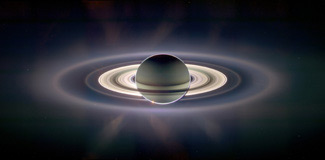Cornell astronomer describes 'an eerily beautiful sight' as Cassini mission finds faint new rings around Saturn
By Lauren Gold

Like suspended dust grains caught in a shaft of light, the tiniest of Saturn's ring particles were on glimmering display for 12 hours last month as NASA's Cassini spacecraft passed into Saturn's shadow and collected images of the ethereally backlit ring system.
From this new perspective, Cassini caught sight of faint new rings in the system, including two orbiting along with their small parent moons outside the main ring system and two within the Cassini Division (the largest gap in the main ring system). The spacecraft had also spotted a dynamic rippled pattern in the system's innermost D ring.
Cornell astronomers and colleagues on the Cassini team presented the latest data and images from the Saturn mission at a recent Division for Planetary Sciences meeting of the American Astronomical Society in Pasadena, Calif. The observations were made in September, as Cassini orbited 2.16 million km (1.4 million miles) from Saturn and looked down at the unlit side of the rings from 15 degrees above the ring plane.
Using images from NASA's Voyager mission, which passed Saturn in the early 1980s, astronomers can see how the rings are changing over time. A wispy new ring in the Cassini Division (named for its discoverer, 17th-century astronomer Giovanni Cassini), for example, isn't visible in any of the Voyager images; indicating that it may be younger than your average graduate student.
"Saturn's ring system is a very dynamic place, and it's changing as the mission sits there and watches it," said Cassini team member Joe Burns, Cornell's Irving Porter Church Professor of Engineering, professor of astronomy and vice provost for physical sciences and engineering. "Studying the moons and learning about their interactions with the rings will help us understand how the moons formed and perhaps how the Saturn system formed."
The D ring is another example of the rings' changeability. Cassini's images of the outer part of that ring show what look like a series of closely spaced ringlets. "We spent a long time trying to figure out what the heck this was," said Matt Hedman, a Cornell postdoctoral researcher and Cassini team member. "It turns out that what's really going on is, wherever you see a bright spot on the near side, you see a dark spot on the far side, and vice versa. That pattern is something you might expect if the ring were vertically warped."
For clues about how the ring came to be warped, researchers looked back to a view of the rings taken by the Hubble Space Telescope (HST) in 1995 and found the same pattern -- with one difference: Cassini's images have the ripples spaced 30 kilometers (18 miles) apart; the HST images show them 60 kilometers apart.
The likely explanation, said Hedman, is that the ring was tilted slightly out of Saturn's equatorial plane at some point in the past, possibly by a passing meteoroid. Because Saturn is not a perfect sphere (it's a little squashed) the inner parts of a canted flat disk around it will twist faster than the outer parts, leading the ring in transition to be a warped, corrugated spiral -- like the top of a twirled soft ice cream cone.
Mathematical models support the hypothesis, even predicting independently the rate at which the ripples move. "As the thing twists more and more, these ripples will get closer together. It actually works numerically," said Hedman.
In the course of Cassini's mission, the ripples have moved closer by another 2-3 kilometers. Using the model to unwind the spiral back in time, researchers trace the probable impact back to 1984 -- just a few years after Voyager.
"This is the first time we've truly seen the entire ring system," said Burns. "It's an eerily beautiful sight, and one that's evolving right in front of our eyes."
The Cassini-Huygens mission is a cooperative project of NASA, the European Space Agency and the Italian Space Agency. The Jet Propulsion Laboratory (JPL), a division of the California Institute of Technology, manages the mission for NASA.
Media Contact
Get Cornell news delivered right to your inbox.
Subscribe